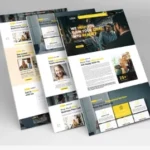A business website is the online face of your company. It represents the brand, the products, and even your company culture to future employees. Your website is the first place leads go when checking out a product or service they’ve heard about. It’s also the first place your potential investors and business partners will go to investigate your brand. Needless to say, a business website has a lot to live up to.
To best represent your brand, your website needs a rock-solid infrastructure, a stylish and useful design, and to stay on the cutting-edge of web design trends for your industry. No website lasts forever. Modular websites and those designed for adaptability last longer, but every website needs to be overhauled every few years. Whether you update the style, the infrastructure, the features, or all three – the time will come to upgrade your business website.
Is this year the time for your business’ next website redesign? Let’s dive into the top reasons why a business would invest in a website upgrade.
1) Become Mobile-Friendly Responsive
One of Google’s biggest recent changes in the Mobile-First policy. This prioritizes websites that perform well on mobile devices, even in PC web browser searches. This brings the most accessible websites to the forefront, but it is also disadvantages websites that are not yet mobile-ready.
Responsiveness in a website design context means responsive to the screen size and orientation. Your website needs to adjust itself so that its elements are both attractive and usable on any size mobile device. Ideally, it will work in both profile (upright rectangle) and landscape (horizontal rectangle). There are several ways to do this, the leading method being modular assets that rearrange themselves for each screen’s size. You may also have multiple versions of things like menus, as different UI styles work best in different contexts.
If your website is not yet mobile-responsive, then it will be kept artificially behind websites that are mobile-friendly. Updating your website is the only way to add a completely new layer of UI and presentation method to a non-responsive web design.
2) Reflect on Your New Brand Design
Brands change over time, and we don’t just mean rebranding. As a business grows and adapts to the customers, the initial brand design can evolve into something new. Often, a few advertising campaigns can serve to reshape a brand, up to new colors, logos, and themes. Your brand may also have reinvented itself recently or changed significantly with an intentional and major effort.
Your website should reflect these brand changes, as it is the primary way your brand is represented to modern customers and partners. If the brand has changed, so too, should your website. In many cases, a new theme, skin, or CSS design might be enough to adapt your colors and imagery. But if your brand has changed significantly in audience or attitude, you might take this opportunity to completely reinvent your online presence with a website overhaul.
3) Ride the Cutting-Edge of Website Features
Web development is one of the hottest technical fields in the industry. There is infinite demand, and businesses are always looking for the next great trend. The trends that stick are the ones worth keeping, and the trail-blazers are the ones remembered for being ahead of the curve. Some of the recent trends worth integrating have been floating live chat and chatbots, live map tracking, and smart home skill integration.
However, each industry has its own unique web design trends. For example, online scheduling tools are all the rage for doctors, lawyers, and field service professionals who all rely on booked consultations. Custom order creation platforms are hot in manufacturing right now, making specialty and repeat orders easier for clients. Integration with back-end software is another essential cutting-edge feature for many industries.
How many of the latest (useful and proven) features does your website currently have? You don’t have to be bogged down by an old website that can’t be quickly updated to the latest trends. A modern and well-designed new website can help you integrate all the best features for your industry and even trail-blaze the next set of web design trends.
4) Leave Behind a One-Developer Design
All too often, a business will have a website that only one person or team can really work with. Hand-built websites by solo webmasters can be great – but they almost always expire too quickly. Any website that has been configured to the custom specs and use of a single person or team will eventually become a burden to the company. That person will either leave or become too valuable to let go. And because they are the only one who understands the website, their time is in unrealistically high demand for the current pace of website updates needed for a modern business.
If your business website is currently entangled in the services of a single developer, it’s time for an update. A good business website can be handed off to any webmaster or team so that no one person becomes so essential that the website collapses without them or they–themselves– are held hostage by the need to manage the website without help.
5) Overcome Page Load Limitations
Page load speed is all-important. Everyone who has done a little reading on SEO or has experience in web development knows this – but how can you improve page loading speed? You can:
lower the “weight” of images and features
offload processes from the webserver
simplify your page designs. Ultimately, you are limited by the efficiency of your current website design.
Just like you can’t make an old junker drive above 60mph, you can’t make an old clunky website load pages faster than it’s empty-page minimum. So if your website’s core infrastructure is what’s holding your page-load-speed back, it’s time for a new website.
6) Start Checking Legacy Errors
No matter how great your website is or how well it works most of the time, errors are a problem. When a customer sees a failed page load or an error message, they lose faith. They may be disappointed, even angry, when they see the message. Customers respond with fear, worried they’ve done something wrong, or their account has been negatively affected because of the error message.
If your website throws errors regularly, and especially if those errors are customer-facing, then there’s no option but to fix it. If the website can’t be repaired — if the problems are too deep — then a new website structure built from scratch without the problem is the answer. Once you’re already rebuilding the website to eliminate errors, you might as well benefit from a full website redesign.
—
Is your business ready to upgrade your professional website? Contact us today!






